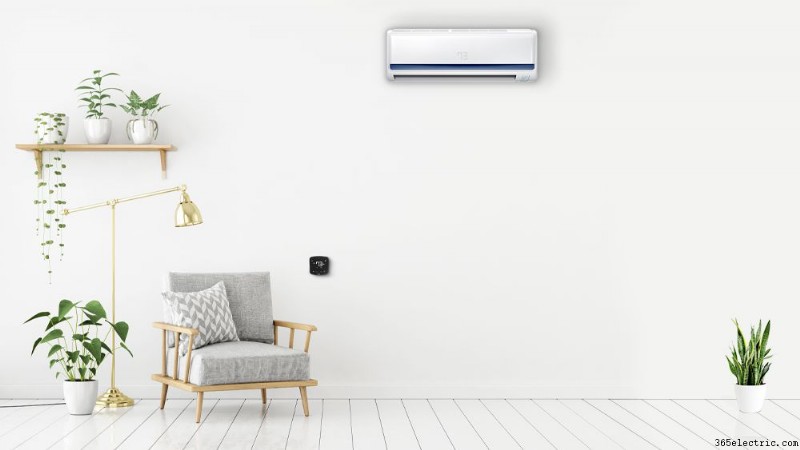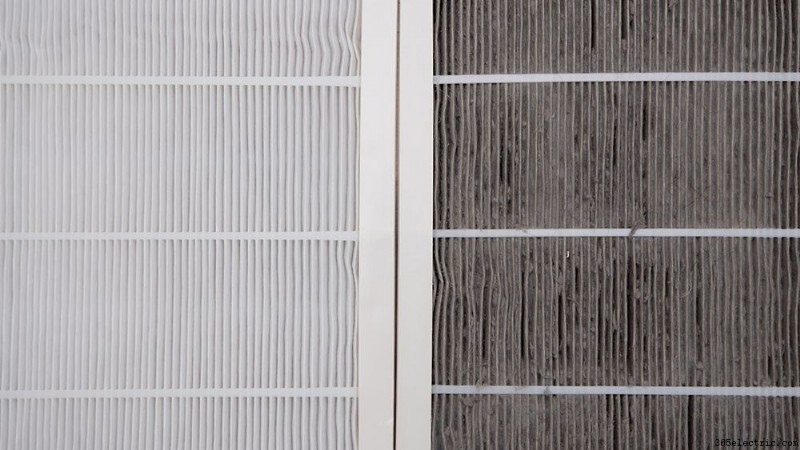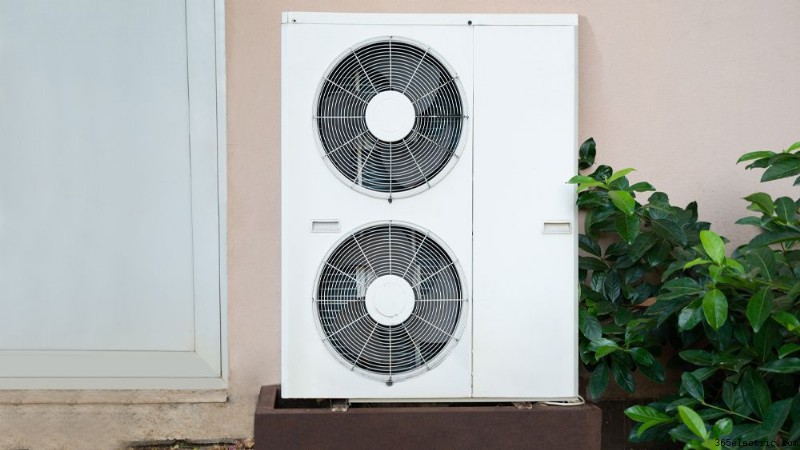Il condizionatore domestico che soffia aria calda? 12 Possibili cause e loro soluzioni

La tua dipendenza dall'aria condizionata aumenta mentre le temperature continuano a salire. Tornare a casa da una lunga giornata di lavoro per scoprire che il tuo condizionatore d'aria ti ha deluso è frustrante nella torrida calura estiva. Potresti scoprire che il tuo condizionatore d'aria sta soffiando aria calda in un audace atto di ribellione.
Caldo e sudato, sei alla disperata ricerca di una soluzione ai tuoi guai. Non preoccuparti, di seguito troverai 12 possibili motivi per cui il tuo condizionatore d'aria soffia aria calda e le loro soluzioni.
Come funziona un condizionatore d'aria?
Prima di iniziare la risoluzione dei problemi, devi sapere come funziona un condizionatore d'aria.
Un'unità AC ha tre componenti principali:una batteria del condensatore, una batteria dell'evaporatore e un compressore. Utilizza anche un agente chimico o di raffreddamento noto come refrigerante, che può passare rapidamente da liquido a gas e viceversa. La serpentina dell'evaporatore contiene il refrigerante gassoso freddo. L'evaporatore soffia aria interna sulla serpentina dell'evaporatore freddo, raffreddando l'aria grazie allo scambio di calore. Quindi, l'aria fredda viene respinta nella tua stanza.
Il refrigerante viene ora inviato al compressore, dove viene convertito in un liquido ad alta temperatura. Quindi viene inviato alle batterie del condensatore e raffreddato da ventilatori che soffiano su di esso. L'aria calda viene trasferita all'esterno e il refrigerante viene raffreddato. Successivamente, il refrigerante liquido freddo viene fatto passare attraverso una valvola di espansione, dove viene convertito in gas freddo e inviato alla serpentina dell'evaporatore.
È importante comprendere i componenti e il processo perché se si verifica un problema con una di queste parti nel ciclo, l'aria condizionata emetterà aria calda.
12 motivi per cui il tuo condizionatore sta soffiando aria calda
Se hai riscontrato una situazione simile, dai un'occhiata a questo articolo per conoscere diversi modi per rinfrescarti senza un condizionatore. Perché risolvere il problema potrebbe richiedere un po' di tempo e nel frattempo non vorresti far sentire la tua casa come un deserto.
Ci possono essere molte ragioni dietro al tuo condizionatore che soffia aria calda. Ecco 12 dei motivi più comuni per cui il tuo condizionatore d'aria ti sta tradendo:
1. Termostato calibrato in modo errato

A volte il tuo condizionatore emette aria calda perché è stato impostato in modo errato.
Ad esempio, se la ventola del ventilatore è impostata su ON, soffia aria tutto il tempo, anche quando non si sta raffreddando. Quindi, soffia aria calda tra i cicli di raffreddamento. Un altro motivo potrebbe essere che potresti aver impostato accidentalmente il tuo condizionatore in modalità riscaldamento. Controllare inoltre se il setpoint è troppo alto. Un'altra possibilità è che il termostato sia calibrato in modo errato e non possa impostare la temperatura ambiente desiderata. Dovresti anche controllare le batterie del termostato o del controller AC intelligente.
Soluzione:
Controlla il termostato e verifica se la ventola del ventilatore è impostata su ON. Se sì, cambialo in AUTO, quindi funziona solo durante i cicli di raffreddamento.
Dovresti anche ricontrollare se il termostato non è in modalità riscaldamento. A volte i vecchi termostati a quadrante sono calibrati in modo errato. Un termostato calibrato in modo errato legge la temperatura in modo errato. Poiché non è in grado di mantenere la temperatura corretta, è necessario regolare nuovamente il termostato di frequente. Se sospetti che il tuo termostato sia calibrato in modo errato, puoi farlo sostituire o ricalibrare da un professionista.
Per i condizionatori d'aria senza condotto, come i mini-split, dovresti anche considerare di investire in controller AC intelligenti come Cielo Breez Plus per mantenere la temperatura all'interno della tua casa costante e precisa. Se hai un condizionatore d'aria centralizzato, dovresti prendere in considerazione l'idea di acquistare un termostato intelligente. Questi dispositivi intelligenti ti rendono la vita molto comoda con le loro funzioni intelligenti e non devi preoccuparti di modificare le impostazioni manualmente.
2. Le prese d'aria di ritorno sono chiuse
Un altro motivo per cui il tuo condizionatore d'aria sta soffiando aria calda è che potresti aver chiuso i registri di ritorno superiori. Poiché l'aria calda sale e l'aria fredda scende, la chiusura dei registri di ritorno superiori significa che l'aria calda rimarrà all'interno della stanza e non verrà inviata all'unità HVAC per il raffreddamento.
Se disponi di un condizionatore d'aria centralizzato, potresti aver aperto le prese d'aria di ritorno inferiori in inverno e chiuso le prese d'aria di ritorno superiori. C'è la possibilità che tu abbia dimenticato di riaprire le prese d'aria di ritorno. A volte, anche mobili, sporco e detriti possono bloccare le prese d'aria di ritorno.
Soluzione:
Fai un giro per casa e controlla se tutti i registri dei resi sono aperti. Se hai problemi a capire se le prese d'aria di ritorno sono aperte, tieni un fazzoletto a una distanza di sei pollici. Se i tuoi registri di ritorno sono aperti, sentirai che il fazzoletto viene tirato nello sfiato di ritorno.
3. Perdita di refrigerante
Il refrigerante è il fluido all'interno dell'AC che assorbe il calore dall'aria e raffredda la stanza. Se si verifica una perdita di refrigerante, l'unità diminuirà gradualmente il suo agente di raffreddamento. Di conseguenza, il fluido refrigerante rimanente potrebbe non essere sufficiente per raffreddare la tua stanza.
Bassi livelli di fluido refrigerante possono anche portare il condizionatore d'aria a soffiare aria calda. Se il tuo condizionatore non si raffredda correttamente, una delle prime cose da controllare è una perdita di refrigerante.
È possibile individuare una perdita di refrigerante osservando le serpentine dell'evaporatore e del condensatore. Anche se dovrebbero essere freddi al tatto, non dovrebbero essere congelati. Un altro segno rivelatore di una perdita di refrigerante sono i sibili e le bollette energetiche inspiegabilmente elevate.
Soluzione:
Non tentare mai di riparare da soli una perdita di refrigerante. Una perdita di refrigerante è un pericolo per la salute e la sicurezza. Chiama immediatamente il tuo tecnico HVAC non appena sospetti una perdita di refrigerante.
4. Filtri dell'aria sporchi

Un filtro dell'aria sporco è un altro motivo comune alla base di un AC che soffia aria calda. I filtri dell'aria sporchi causano problemi di flusso d'aria in tutto il sistema e possono surriscaldare il motore della ventola. Aumentano anche il consumo di energia poiché costringono l'unità HVAC a funzionare con un'impostazione di potenza più elevata. Quindi, se il tuo condizionatore sta soffiando aria calda, tieni d'occhio i filtri dell'aria sporchi.
Di solito, un'ispezione visiva è più che sufficiente per vedere se i filtri dell'aria sono sporchi. Rimuovere i filtri dell'aria e tenerli sollevati. Se riesci a vedere attraverso di essi, i tuoi filtri dell'aria sono puliti. Se sono intasati di sporco, devono essere puliti o sostituiti.
Soluzione:
In media, dovresti pulire i filtri dell'aria ogni due settimane e sostituirli ogni 3-4 mesi. Per prima cosa, pulisci i filtri dell'aria lavandoli con acqua e sapone. Quindi lasciali asciugare all'aria o usa un panno morbido e asciutto per rimuovere l'umidità.
Ecco una guida completa per pulire il tuo condizionatore d'aria, così sarai sempre aggiornato sulla manutenzione.
5. Batterie dell'evaporatore sporche
Una serpentina dell'evaporatore trattiene all'interno il refrigerante refrigerato. This chilled refrigerant in the evaporator coil removes heat from your room when air from the blower fan moves over it. A natural by-product of this process is condensation.
When there is moisture on the coils, they become more prone to getting dirty because dust particles stick to them. Since the evaporator coil works through absorption, it loses its cooling ability if covered in dust. Hence, dirty evaporator coils can lead to your air conditioner blowing warm air.
A dirty evaporator coil also causes more wear and tear on your HVAC unit and can reduce its lifespan. Debris on evaporator coils can also lead to ice buildup.
Solution:
Turn off power to your AC unit and, to be on the safe side, turn off the circuit breaker as well. Locate the indoor access panel and unscrew it. Look at the evaporator coils and see if there is any dust or debris on them.
On average, you should be cleaning your evaporator coils every two months. Use a soft-bristled brush to remove any dust particles or debris. Use a coil comb to clean the area between the coil fins, taking great care not to bend the fins. If you do see any bent fins, gently straighten them with a fin comb. You can also use other methods to clean evaporator coils, such as the compressed air technique.
6. Frozen Evaporator Coils
When the evaporator coil removes heat from the air to chill your room, it leads to condensation. Air conditioners have a condensate drain to remove this moisture from the system. When too much water collects on the evaporator coil, it can freeze over. A frozen evaporator coil prevents heat transfer which can lead to your home AC blowing warm air.
Solution:
To check if you have frozen evaporator coils first shut off power to your AC unit. For extra safety, also turn off the circuit breaker. Then open the indoor access panel and check for any frost or ice on the evaporator coil. To find out where the access panel is located, consult your AC’s instruction manual, then remove any screws or fasteners to gain entry to the access panel.
If you see any frost or ice on your evaporator coils, let them thaw. Do not turn the AC on until any frost has melted completely.
If letting them thaw in the open air is taking too much time, you can use a hairdryer over the coils at the lowest setting. Keep the hairdryer at a safe distance from the evaporator coils, so you don’t damage them.
If the problem reoccurs, you will have to contact a seasoned HVAC professional.
7. Dirty Condenser Coils
Condenser coils are located inside your AC’s outdoor unit. The condenser’s job is to release the hot air from your room outside. Since the condenser coils are in the outside unit, they gather a lot of dust and debris and become clogged with leaves and small branches.
If your condenser coils are dirty, it may result in AC blowing hot air because it cannot effectively expel heat outside.
Solution:
Turn off your AC unit and the circuit breaker. Then remove the condenser cover. Inside, you will see a cage. Unscrew the cage and remove it. After you have removed the cage, you will see the condenser coils. Inspect to see if you find any leaves, dust, or debris.
Manually remove any leaves or small branches. Then, use a soft-bristled brush to clean condenser coils.
8. Lack of Electricity to the Outside Unit
Both your indoor and outdoor AC units need electricity to run. If electricity to your outdoor unit is interrupted, your indoor unit will blow warm air since the outdoor unit can no longer release heat outside. Therefore, if your home AC is blowing warm air, you should check whether the outdoor unit is getting power.
Solution:
Locate your electrical panel and check your circuit breaker to see if it has tripped. Also, keep an eye out for any blown fuses. You can identify a blown fuse using these steps:
- Turn off electrical power to the unit.
- Remove the fuse from its holder.
- Look at the fuse wire. If you can see a visible gap or a dark smear in the glass, you have a blown fuse.
Use a multimeter if you cannot visually confirm whether the fuse is blown,
If the circuit breaker has tripped, first turn it off completely, then turn it back on. Replace any blown fuses. However, if the fuse keeps blowing repeatedly or the circuit breaker keeps tripping, it is a sign that something more is wrong. In that case, consult a certified electrician.
9. Fan Problems

The fan in your outdoor unit is responsible for transferring indoor heat outside your home. If this fan is damaged, proper heat transfer does not take place. Lack of suitable heat transfer can then lead to your AC blowing warm air.
Solution:
Fan problems can be due to a wiring issue or dirt and debris stuck in the fan. Turn off the power and remove the outside cover. Manually remove any dust you may see.
If your fan problems do not resolve after cleaning, consult a certified HVAC professional.
10. Clogged Drainpipe
The AC condensate drain removes water collected during the cooling process. This water is collected in the drain pan and then flows into the drainpipe. Over time the drainpipe can become clogged with debris and mold. When this happens, water can overflow and damage your aircon unit.
Solution:
Signs of a clogged drain line include water damage near your indoor unit and a musty, moldy scent. Some clogs can be removed by hand while wearing protective gloves. For deeper clogs, use a wet dry vacuum. Attach it to the end of the drainpipe and seal it securely with duct tape. Turn the vacuum on to suck any clogs.
For stubborn clogs, prepare a mixture of one cup bleach and one cup water. Pour it down the drainpipe to dissolve any debris. After cleaning the drainpipe, empty the drain pan and wipe it down. Make sure there is no moisture left; otherwise, it can lead to mold growth.
11. Leaking Ducts
If none of the above-mentioned reasons sort out your problem and you’re still wondering why your AC is blowing warm air, you may want to take a look at your ducts.
There may be a leak in your ductwork caused by rodents or poor installation. If there are holes in the ducts, cold air will not reach you and may get lost on its way. Leaking ducts can cause you to lose roughly 20 to 30 percent of conditioned air, resulting in insufficient cooling and high energy costs.
Solution:
Use mastic sealant or metal tape to seal any air leaks. Further, seal vents and registers where they meet any surface, such as the ceiling. However, since most of your ductwork is hidden, if you suspect a leak deep inside, you will have to contact a professional to locate the leak and fix it.
Faulty ducts are frequently the reason behind your air conditioner blowing hot air; therefore, it is a good idea to conduct proper inspection after some time.
12. Faulty Compressor
The compressor, also considered the heart of your HVAC unit, handles refrigerant circulation within the unit. If the compressor isn’t working properly, your air conditioning unit will not cool as it should.
Signs of compressor failure include weak or warm airflow, loud banging noises, etc. A faulty compressor is one of the main reasons why your AC blows warm air.
Solution:
Repairing an AC compressor is not doable for the average layperson. Consult a certified HVAC technician who will diagnose the problem and decide whether it is fixable. Repairing AC compressors is often cost-ineffective and sometimes replacing the whole unit is cheaper. You should carry out regular maintenance of your AC to prevent costly repairs such as compressor failure.
Your AC blowing warm air can ruin your whole mood and day, especially if you live in an area prone to heat waves. However, with these troubleshooting tips at your disposal, you are sure to remain cool and relaxed throughout the summers and beat the heat.
